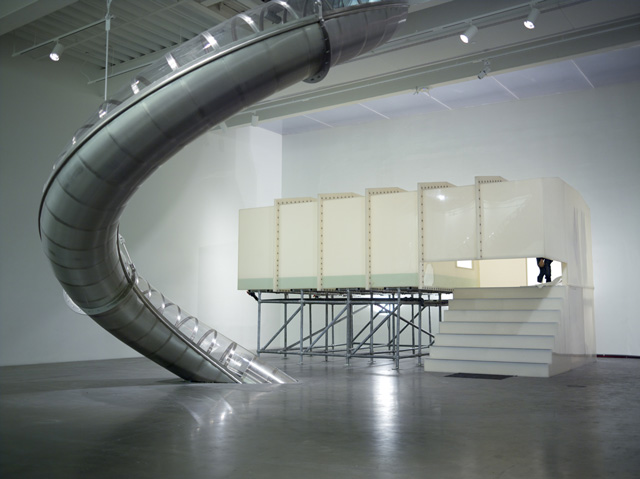
Untitled (slide) by Carsten Höller. Photo Credit: Noah Kalina, Katie Sokoler/Gothamist.
“The point of this exhibition is to disprove your expectations,” New Museum employee Kimberley Mackenzie noted, referring to the museum’s current survey of works by German artist Carsten Höller. Part test site and part laboratory, the exhibition takes the concept of a “visitor experience” to the next level. The participation requires museum-goers to sign a legal waiver on the ground floor, after which they pass the fittingly placed mushroom sculptures and enter an adult playground of interactive art. Depending on how willing you are to suspend your belief (and body), the exhibition offers a wide-ranging selection of experiences, all far from any conventional idea of museum installations.
For the hesitant, the upper floors offer a room of flashing lights, a fish tank with a hole for your head, parakeets, a mirrored carousel, and a moving tunnel. For the more advantageous, a 102-foot slide penetrates the main gallery floors and takes a total of four seconds to ride (and is becoming progressively faster as riders further indent the steel), and the Experience Corridor offers a number of self-experiments. For the dauntless, there are Upside-Down Goggles, which give the user inverted vision and make you so prone to falling that use requires leaving a credit card at the desk, and the Giant Psycho Tank, a sensory deprivation pool filled with literally a ton of salt, set at the same temperature as the human body, meaning to emulate the Dead Sea. Participation in the tank requires either the removal of all clothing or only wearing a swimsuit.
While such a wild menu of experiences would naturally seem the product of an artist, Mr. Höller, 49, in fact began as a biologist. After writing his dissertation, “Overwintering and hymenopterous parasitism in autumn of the cereal aphid Sitobion avenae (F.) in northern FR Germany”, which focused on agricultural science, specifically the area of insects’ olfactory communication strategies, Mr. Höller found himself bored with the idea of research and began making art in the late 1980s.
Certainly his work has brought a fresh atmosphere to the New Museum. “We’ve never had so many children at an exhibition before. We’ve never had so many people, in general,” Kimberley commented. And it’s true: while the New Museum has always offered avant-garde art by free thinking artists, this current exhibition of participation based installations is bringing in a far less elite crowd, with a much younger mean and a decent amount of families. While the museum’s last exhibition, Ostalgia, featured a graphic spread of intimate, at times pornographic, photography from Soviet artists which attracted, predictably, no families and an audience of mainly the middle-aged or the incredibly well dressed, the Carsten Höller Experience brings in more of a downtown group closer to college age.
As to whether this change in crowd and shift from art to experience will persist in the next few exhibitions, it would seem that the New Museum is booked too far in advance for the success of Carsten Höller to have an effect for a year or two to come. “The exhibitions are booked very far in advance,” Kimberley told me, “so the success of Carsten Höller may influence exhibitions farther down the line, but nothing will be changed about the next few.”
On view until January 15, the exhibition is free for anyone 18 or under (although the presence or signature of a legal guardian is required to participate in the slide, tank, carousel, or goggle use), and is certainly worth checking out.
Comments
Leave A Comment